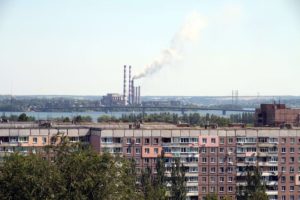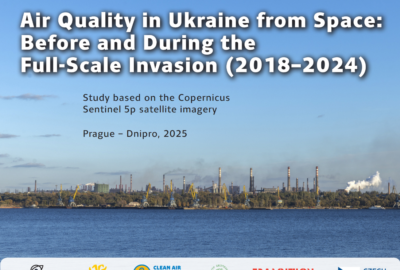Almost the entire Dnipropetrovsk region is heavily polluted. The environmental situation in the region is characterized as an emerging crisis. Gross pollutant emissions in the air exceed 1 tonne per year. The Dnipropetrovsk Oblast is dominated by the mining industry; the concentration of plants in the region is very high and the level of environmental safety of the equipment and the cleaning systems is extremely low.
Stationary sources account for 82% of all air pollutant emissions. The region is one of the most polluted in Europe. In industrial areas there is a large concentration of metallurgy, mining, engineering, and chemical plants. The most difficult situation is in the areas where there is intensive mining and processing of mineral resources: the Dnipropetrovsk-Dniprodzerzhynsk agglomeration, Kryvbas, West Donbass, and the Nikopolskiy Raion.
On average, in the area, the amount of harmful emissions is 28 tonnes per km2. In Ternivka, where the DTEK “Pavlogradvugylja” shafts are situated, the amount is 100 times higher, in Krivyi Rih 35 times, in Kamianske 32 times, in Pokrov and Nikopol 17 times, and in Dnipro six times higher.
Major polluters
The list of major polluters in the Dnipropetrovsk Oblast remained practically unchanged between 2010 and 2015:
- ВАТ «АрселорМіттал Кривий Ріг» /ArcelorMittal Krivyi Rih
- ВП «Криворізька ТЕС» /Krivorizka TES
- ПАТ «ДТЕК Дніпроенерго» /DTEK Dniproenergo
- ВАТ «Дніпровський меткомбінат ім. Дзержинського» /Dniprovskyi metkombinat im. Dzerzhinskogo
- ВП «Придніпровська ТЕС» / Pridniprovska TES
- ПАТ «ДТЕК Дніпроенерго» / DTEK Dniproenergo
- ВАТ «Південний ГЗК» /Pivdennyi GZK
- ВАТ «Нікопольський завод феросплавів» /Nikopolskyi zavod ferosplaviv
- ВАТ «Орджонікідзевський ГЗК» /Ordzhonikidzevskyi GZK
- ВАТ «Євраз-ДМЗ» /Evraz – DMZ
- ВАТ «ІНТЕРПАЙП Нижньодніпровський трубопрокатний завод» /Interpipe Nizhnodniprovskyi truboprokatnyi zavod
- ВАТ «Центральний ГЗК» /Centralnyi GZK
Characteristic features of emissions into the atmosphere on the territory of the Dnepropetrovsk region are a significant metal content (as a result of the operation of metallurgical plants) and a very high content of hydrogen sulphide.
With regard to the amount of hydrogen sulphide emissions, the Dnipropetrovsk region occupies first place in Ukraine and the highest occurrence of acid rain is observed here.
The occurrence of SO2 in the atmosphere is mainly due to the processes of heating and industrial production. Some of the sulphur compounds are released by the combustion of organic residues in ore dumps. The largest amount of hydrogen sulphide emissions is produced by Krivorizka TES. Additionally, a high content of solids is recorded in the air of the region: up to 130,000 tons.
What do the residents of Dnipro breathe?
The two major air polluters immediately in the city of Dnipro are Pridneprovskaja TES and Evraz DMZ. Besides these giants, the number of enterprises in the city that use shadow schemes has increased. Such operations work quite legally, but they turn off cleaning filters at night because the cost of cleaning represents a large percentage of the plant’s production costs. This saves money at the expense of urban air.
It’s difficult to find out how polluted the air in the city is because the city hall does not have the necessary laboratory equipment, the laboratory itself, or the specialists who can do this job.







